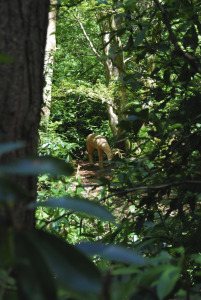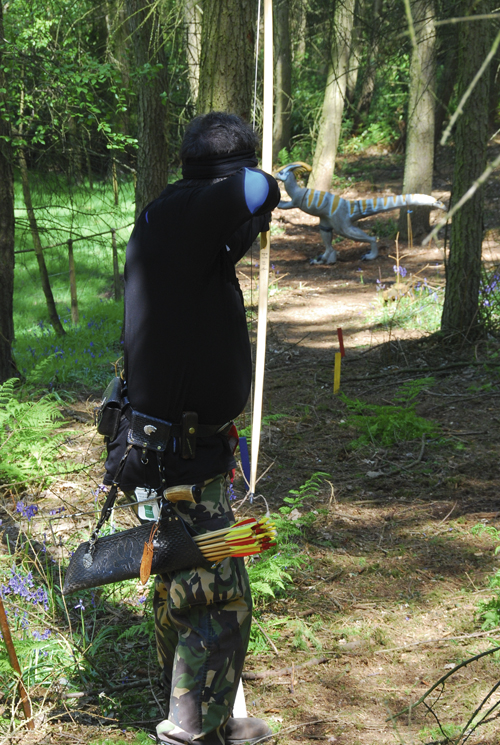Considering taking on an unmarked field round? Alex Tyler explains how to start judging distances
Shooting over unmarked distances is the area where the difference between field and target archery is most obvious. Target archery tests the archer’s ability to consistently hit a known distance. Marked field archery provides an additional level of challenge in terms of the terrain and varying target sizes. Unmarked field archery adds a further layer of uncertainty. Rounds can range from set sizes of targets with known maximum and minimum distances, as in FITA and EFAA (English Field Archery Association) field rounds, to NFAS (National Field Archery Society) where no guidance on target placement is given and targets can be of any dimension at any distance.
Unlike target, as sighters are not allowed in field rounds, there is no opportunity to practise and each shot of the course (up to 40, dependent on the round and society) will be different. How an archer approaches an unmarked shot will depend on their equipment and shooting style.
The first option, for unsighted archers, is to shoot purely instinctively, with no attempt to judge the distance to the target. We all do this naturally in normal life: when something needs to be thrown in the bin, we don’t think, we just throw. Whether the item goes in is normally a function of whether it flies as we think it will, depending on how aerodynamic it is. This is instinctive distancing judging at its most basic – we don’t assess how far away the bin is, the wind speed or any other factor, except nowadays making sure we have chosen the correct bin for recycling purposes.
Take away the uncertainty of how the projectile will fly and you have the principle behind instinctive archery. Often used with traditional bows and wooden arrows, it relies on the archer’s snap judgement to place the arrow. This technique relies on a considerable amount of experience, and the archer having absolute consistency in the draw and loose.
If you have sights, or don’t have the experience to trust your instinctive abilities to that level, you can attempt to judge the distance to the target and adjust your aim accordingly. The course layer will be deliberately setting out to make this distance-judging challenging, by using natural features of the terrain such as dead ground or slopes between shooting pegs and targets. The distance-judging technique used must try to account for these potential tricks. Although binoculars are allowed in FITA field, no society allows any equipment to aid distance-judging such as rangefinders.

If the boss sizes are regular, or the target size roughly known, you can use the size of them in relation to something to help get an idea of how far away it is
If there is a common reference point around the course, such as the use of a consistent boss size for paper animal faces or roundels, then, providing you know how big the item actually is, you can use its relative size at each target to estimate the distance. You are allowed to use a comparator, such as the size of the boss against your sight ring to further judge the distance, but cannot specifically modify your equipment to judge distance. The problem with this method is that it can be confused if there is no standard size reference, for example when shooting 3D animal targets or where boss sizes vary.
If the target’s size is roughly known, you can use a close object reference. Any item that is easily held, such as a pen or your thumb, can be held up towards the target and the distance judged by how large the target appears in relation. This relies upon knowledge of the size of the targets, but can help to cancel out the effect of slopes, which will make objects appear closer if uphill and further away if downhill. However, this will not work if it is an unfamiliar target or where the target is partially obscured (permitted in NFAS). Also, there can be significant variation between the sizes of targets from different manufacturers.

3D targets are harder to judge – especially if they are different sizes. A deer from one manufacturer might be a different size to one from another
Measuring the actual distance to the target can be done in two ways: by range referencing or by using objects on the ground. To range reference, the archer assesses a ‘known’ distance that they can estimate well and counts the number of times that distance occurs. This method may miss dead ground that is invisible from the peg and the longer the distance, the harder it becomes to measure consistently. To counter this, the distance can be measured in sections by using natural markers such as trees or rocks on the way to the target.
A disadvantage of this method is that these natural features are likely to be irregularly spaced, or, if the shot is in open grassland, not there at all. For second shots from the same peg, the placement of the arrow in the boss and the time between the loose and impact will give further indications of distance to refine the original estimate. If moving between pegs, the distance from the first peg to the second can be assessed quickly, being shorter, and can be used as a reference point.
Where there remains uncertainty over distances, there are techniques for maximising the chances of hitting a target. Where torn between two, taking an average of the two should get the arrow onto the target. When shooting 3Ds, it is aiming for the line of the front leg, so that if the line of the arrow is correct, the arrow has the greatest available height of target to hit.
Whichever technique is used for shooting, practice is useful to develop your ability. It is possible to practice distance judging away from an archery course by estimating distances to items, then pacing the distance to check it. It is also important to have a solid technique, so that the only variable in each shot is the aiming point, though if the course layer has done their job really well, unmarked field archery will always be a challenge.


